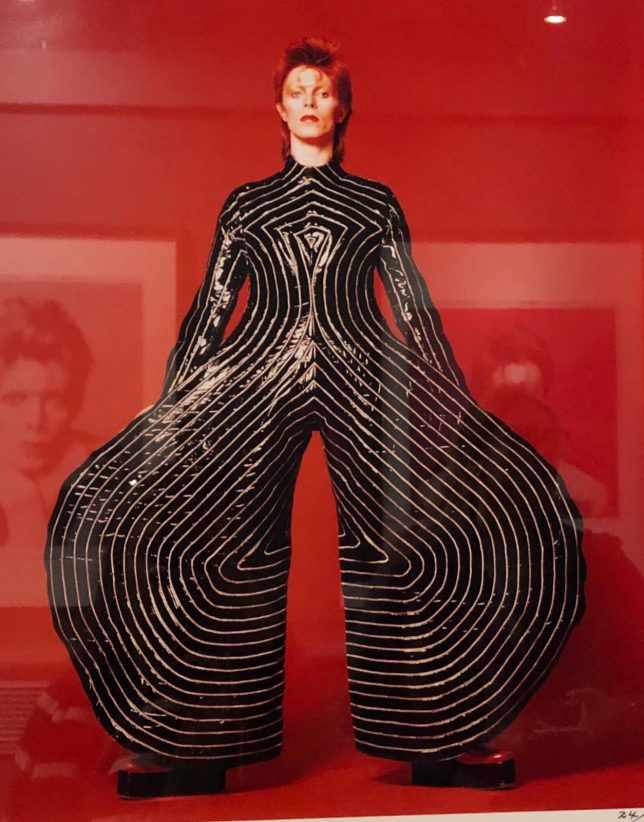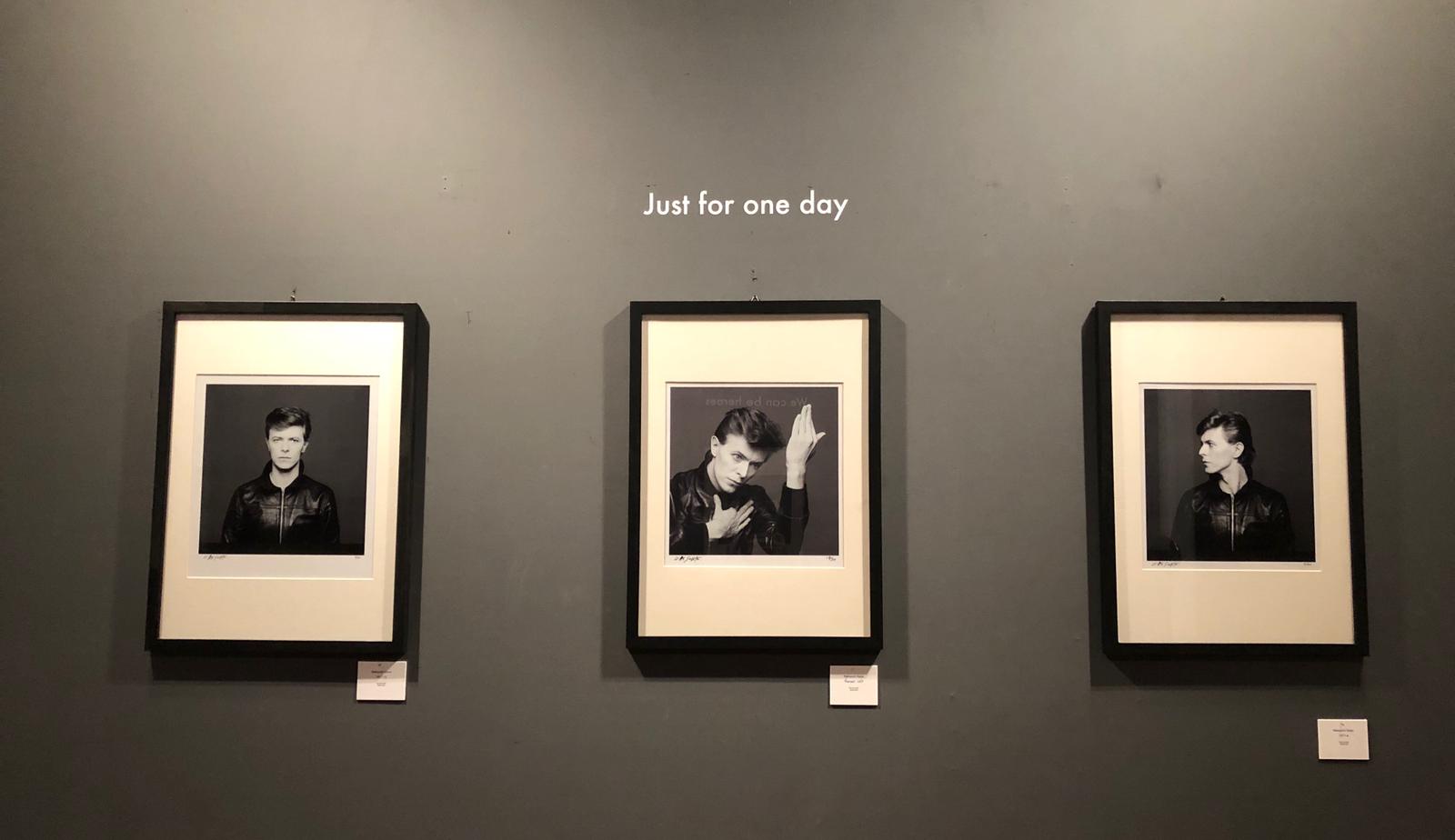
Heroes – Bowie By Sukita
The White Duke lives again at Palazzo Medici Riccardi
By Camilla Nardelli and Camilla Torracchi (Università di Firenze)
Palazzo Medici Riccardi, Florence (30 March – 28 June 2019)
Monday-Sunday: 9-19
Tuesday: closed
It was the 10th of January when the world mourned the unexpected loss of one of the most important and controversial figures of music from the 20th century: David Bowie. Three years later, his life, his music, and personality are being celebrated with the exhibition Heroes – Bowie By Sukita in one of the of the most prestigious spaces of the city of Florence: Palazzo Medici Riccardi. This is the first Italian exhibition for the great Japanese artist Masayoshi Sukita, and internationally renowned photographer, Curated by ONO Contemporary Art and open until 28 June, 2019.
Through a careful selection of approximately 90 photographs, many of those presented to the Italian public for the first time for the occasion of the exhibition, the White Duke is recounted by the artist Masayoshi Sukita in an attentive and precise manner, from the 70s to the early 2000s. David Bowie is shown on the stage and in the backstage bringing to light a hidden side of the artist that is entertaining and always fascinating.
The union between Sukita and Bowie began in 1972 when the Japanese photographer, who had come to London to immortalize Marc Bolan and T-Rex, decided to go see a concert by the London artist, who in those days was known as Ziggy Stardust. On that stage Sukita saw something special that, as he recounts in an interview, he absolutely had to capture with his camera. Thanks to the intervention of designer Yasuko Takahashi – friend of the Rockstar and designer of his clothes – he was able to meet Bowie. From that moment their forty-year working and personal relationship began.
For lovers of the London artist the exhibition is a beautiful leap into the life and career of the Rockstar seen through the shots of an excellent photographer, a passionate fan, but above all a lasting friend.
The retrospective is presented in a chronological itinerary with photographs in black and white and color, displayed on a grey background, starting from the beginning of the union of the singer and Japanese artist. And thus it is possible to know both the art of Sukita and that of Bowie, the absolute protagonist of the photos, as an era lived through shots that immortalize, for example, Iggy Pop close to Bowie both as a friend and colleague. A part of the exhibition is entirely dedicated to Heroes and includes the photoshoot from which the iconic shot used for the cover of the namesake album, released in 1977, was taken. The retrospective of the singer then progresses with more intimate photographs shot by Sukita of Bowie in Japan and concludes with a wall entirely covered by his albums that can’t help but to captivate the most passionate fans. The public finds itself strolling through the rooms of the exhibition accompanied by the highlights of the artist’s great successes, around forty selected tracks reproduced in during the exhibition’s opening hours, and from the stories of his life told by explanatory panels in written in Italian and English. At times there is the impression that David Bowie is caught in extravagant poses trying to capture contact with the public, and others he seems impassive in front of the lens, but he is always capable of holding the observer’s gaze. A stimulating and curious aspect is the interactive element proposed to visitors, who have the possibility to wear the artist’s leather jacket and immortalize themselves with a selfie or in a photo with a gigantic poster of the album Heroes behind them, in which the jacket is worn by Bowie himself.
Honoring an artist like Bowie is not simple, especially in a city like Florence that was so well loved by the Rockstar that he chose it as the location for his wedding. The city decided to do so by placing the exhibition in the lemon tree courtyard of Palazzo Medici Riccardi, the historic Medici residence, that, like Bowie, a versatile personality, has been the stage for art, music and entertainment. Opening the doors of the building, designed by Michelozzo, to the exhibition, the ancient and modern come together permitting visitors, through a single ticket, to admire the rooms occupied by the exhibitions and those of the palace in all its magnificence. This connection between the antique and the modern is a winning combination that Palazzo Medici Riccardi had the opportunity to experiment with in the previous retrospective on BANKSY- This is not a photo opportunity.
The exhibition is promoted by OEO Firenze, the association of Le Nozze di Figaro with the Metropolitan City and the Municipality of Florence. The photographic exhibition is also accompanied by a rich program of events connected to the show, including concerts held in the palace’s courtyard.
Translated by Marie-Claire Desjardin (Istituto Lorenzo de’ Medici)

Heroes – Bowie By Sukita
The White Duke rivive a Palazzo Medici Riccardi
Di Camilla Nardelli e Camilla Torracchi (Università di Firenze)
Palazzo Medici Riccardi, Firenze (30 marzo – 28 giugno 2019)
Lunedì-domenica: 9-19
Mercoledì: chiuso
Era il 10 gennaio del 2016 quando il mondo piangeva la perdita inaspettata di una delle figure più importanti e controverse della musica del XX secolo: David Bowie. A distanza di tre anni, la sua vita, la sua musica e la sua personalità vengono celebrate con la mostra Heroes – Bowie By Sukita in una delle cornici più prestigiose della città di Firenze: Palazzo Medici Riccardi. Si tratta della prima personale italiana del grande artista giapponese Masayoshi Sukita, fotografo di fama internazionale, curata da ONO Arte Contemporanea e visitabile fino al 28 giugno 2019.
Attraverso un’attenta selezione di circa 90 fotografie, molte delle quali presentate al pubblico italiano per la prima volta proprio in occasione di questa mostra, il Duca Bianco viene raccontato dall’artista Masayoshi Sukita in maniera attenta e precisa, dagli anni ’70 ai primi anni 2000. David Bowie viene mostrato sul palco e nel retroscena mettendo in luce un lato dell’artista nascosto e divertente ma sempre affascinante.
Il connubio fra Sukita e Bowie inizia nel 1972 quando il fotografo giapponese, giunto a Londra per immortalare Marc Bolan e i T-Rex, decide di andare a vedere un concerto dell’artista londinese che, a quei tempi, vestiva i panni di Ziggy Stardust. Su quel palco Sukita vide qualcosa di speciale che, come racconta in un’intervista, doveva per forza bloccare con la sua macchina fotografica. Grazie all’intercessione della stilista Yasuko Takahashi – amica della rockstar e disegnatrice dei suoi abiti – riuscì a conoscere Bowie. Da quel momento iniziò un rapporto lavorativo e di amicizia lungo quarant’anni.
Per gli amanti dell’artista londinese la mostra è un bellissimo salto nella vita e nella carriera della rockstar vista tramite gli scatti di un fotografo eccellente, di un fan appassionato, ma soprattutto di un amico duraturo.
La retrospettiva si articola in un percorso cronologico con fotografie in bianco e nero e a colori, disposte su un fondo grigio, partendo dagli inizi del connubio fra il cantante e l’artista giapponese. È così possibile conoscere opera dopo opera sia l’arte di Sukita, sia Bowie, protagonista assoluto delle fotografie, come l’epoca in cui è vissuto attraverso alcuni scatti che immortalano, ad esempio, Iggy Pop vicino a Bowie sia come amico sia come collega. Una parte della mostra è interamente dedicata ad Heroes e include la sessione fotografica dalla quale è stato estratto l’iconico scatto utilizzato come copertina dell’omonimo album uscito nel 1977. La retrospettiva sul cantante prosegue poi con fotografie più intime scattate da Sukita a Bowie in Giappone e si conclude con una parete interamente ricoperta dai suoi dischi che non potrà che catturare tutti i fan più appassionati. Il pubblico si trova così a passeggiare fra le sale della mostra accompagnato dalle note dei grandi successi dell’artista, circa una quarantina di brani selezionati riprodotti nell’orario di apertura dell’esibizione, e dal racconto di alcuni momenti della sua vita scritti su pannelli esplicativi in italiano e in inglese. A volte si ha l’impressione che David Bowie colto in pose stravaganti cerchi il contatto con il pubblico, altre sembra impassibile di fronte all’obiettivo, ma sempre capace di rapire lo sguardo degli osservatori. Un aspetto stimolante e curioso è l’interazione proposta ai visitatori, i quali hanno la possibilità di indossare il giacchetto di pelle dell’artista e immortalarsi così in un selfie o in una foto con alle spalle una gigantografia della copertina dell’album Heroes, nella quale era indossata dallo stesso Bowie.
Onorare un artista come Bowie non è semplice e soprattutto per una città come Firenze che è stata talmente tanto amata dalla rockstar da sceglierla come location per le proprie nozze. La città decide di farlo collocando la mostra nella limonaia di Palazzo Medici Riccardi, antica residenza medicea, che, come Bowie, personalità poliedrica, è stata palcoscenico di arte, musica e spettacolo. Aprendo le porte del palazzo progettato da Michelozzo alla mostra, antico e moderno si fondono e permettono al visitatore, tramite un solo biglietto, di ammirare le sale inerenti all’esposizione e quelle del Palazzo in tutta la loro magnificenza. Questo legame fra antico e moderno è un’unione vincente che Palazzo Medici Riccardi ha potuto già sperimentare con la precedente retrospettiva su BANSKY – This is not a photo opportunity.
La mostra è promossa da OEO Firenze, l’associazione Le Nozze di Figaro con Città Metropolitana e patrocinata dal Comune di Firenze. L’esposizione fotografica è inoltre corredata da un ricco programma di eventi legati alla mostra, fra cui si segnalano concerti in acustico che si terranno proprio nel cortile del palazzo.
Photo courtesy Camilla Torracchi